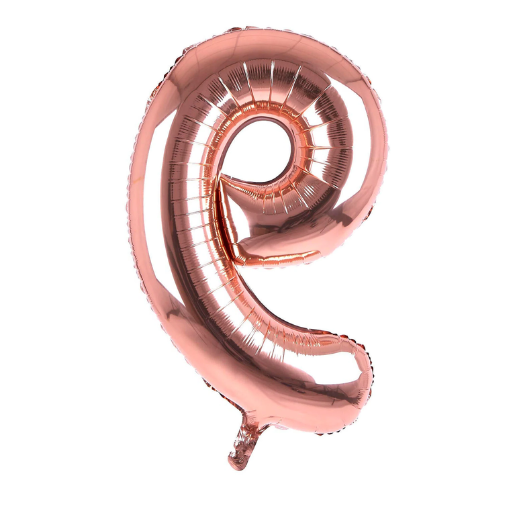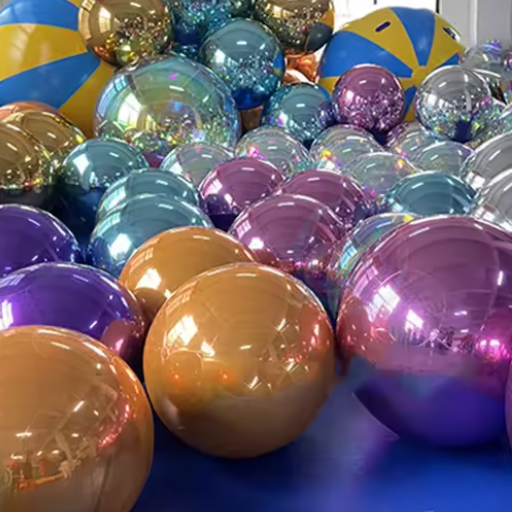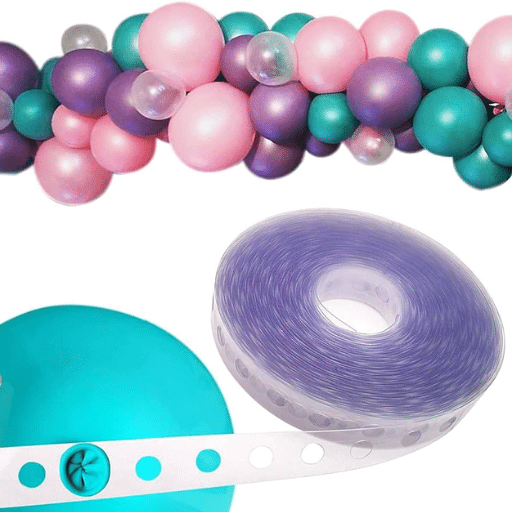Number balloons are a beautiful choice for birthdays, anniversaries, and other special occasions. The bold design of numbers adds a little bit of drab festivity to any occasion, though, and just like with giant decorations, you may find yourself wondering what to do with them post-celebration. Deflating foil and Mylar number balloons can seem a bit tricky at first, especially if you want to reuse them for upcoming celebrations. This guide will simplify that process for you and help you deflate the balloons splendidly so they remain intact for reuse or perfect storage! By completing this step-by-step guide, I am confident that you will have no daunting hurdles regarding balloons.
Understanding Balloons and Their Types

Foil and Mylar balloons are durable and shiny, while latex balloons are stretchy and biodegradable. For example, a thin sheet of metalized plastic is the hallmark of foil and Mylar balloons, which can resist air leakage and therefore make them the best option for reuse. On the other hand, latices are from natural rubber, tend to stretch more, but deflate faster. Considering these characteristics, one should know well about the balloon they are dealing with to treat, store, or deflate it properly.
Overview of Foil and Mylar Balloons
Occasionally, the terms are interchanged, but both foil and Mylar balloons are manufactured from materials that confer sturdiness and beauty to them. Made from a thin, malleable yet strong layer of metalized plastic film, they are usually preferred for their shiny and reflective surfaces, as well as their resistance to air leakage. According to recent research, an ordinary foil balloon can float much longer, in some cases weeks, when properly sealed, compared to latex balloons. Hence, they are more suitable for events or gatherings that require a duration for decoration, such as birthdays, anniversaries, or store openings.
According to statistics, foil balloons retain helium for approximately 3-5 days, possibly longer in the case of top-notch foil balloons under ideal conditions. Their demand is increasing for local and corporate branding, where logos and intricate designs are best suited for a smooth and sturdy surface. On the downside, these balloons pose an environmental concern as Mylar is not biodegradable and must therefore be disposed of properly or recycled. To stay safe, ensure you never release them outdoors, as they pose a threat to wildlife and power lines. By understanding their characteristics and managing their use responsibly, one has a practical and elegant option in foil and Mylar balloons for any celebration.
Differences Between Helium and Air Inflation
The two most common substances chosen for inflating balloons are helium and air, each with its own unique qualities, uses, and practical considerations.
Helium Inflation: Helium is a lighter-than-air gas that allows balloons to float in the air. This unique property of helium balloons makes them highly sought after for decoration purposes, particularly for weddings, birthdays, and corporate events. Helium sustains the float of latex balloons for approximately 8 to 12 hours, but foil balloons float for several days or even weeks after being properly sealed. Other factors include temperature, humidity, and quality of the balloons that directly affect this were it to be accounted as a rough estimate. It is also worth mentioning that helium tends to increase the cost of balloons, as it is scarce worldwide. According to recent reports, the production of helium is currently constrained, which is driving up the price.
Air Inflation: On the contrary, the air is freely available and does not depend on any limited supply. On the contrary, air-inflated balloons do not float; instead, they can be used to decorate ground displays, garlands, and archways. Air-filled latex balloons have one of the longest lifespans, potentially remaining fully inflated for several days, depending on environmental conditions. Air inflation is also suitable for massive installations where buoyancy is a distraction due to its cheapness and versatility.
Environmental Impact Comparison: Helium is a non-renewable resource, and its overuse would render its already scarce supplies unusable for crucial applications, such as medical imaging (MRI machines). On the other hand, the footprint is slightly lower for air inflation; however, the sustainability of the balloons, whether latex or foil, remains a significant concern.
Data on Longevity and Costs: For perspective, it generally costs between $1 and $3 to fill a standard 11-inch latex balloon with helium, depending on supply and demand. In contrast, air inflation comes with no additional charges beyond the actual cost of the balloon. The float time is shorter without hi-float treatment for helium balloons, whereas air-filled balloons will maintain their appearance for days or even weeks with proper care.
People can then assess their event requirements, budget, and environment considerations to make an informed choice about balloon inflation.
Why Proper Deflation Matters
Responsible balloon deflation is essential to avoid harming the environment. It also reduces the waste generated, in full support of sustainable practices, which is growing higher on the list of pollution and wildlife safety concerns in search trends lately.
Step-by-Step Guide to Deflating a Foil Balloon

|
Step |
Key Point |
|---|---|
|
Locate Tab |
Find the inflation tab on the balloon. |
|
Insert Straw |
Gently insert the straw into the inflation tab. |
|
Release Air |
Push the straw until air starts escaping. |
|
Press Balloon |
Gently press to guide air out. |
|
Fully Deflate |
Continue until the balloon is entirely flat. |
|
Remove Straw |
Carefully remove the straw from the tab. |
|
Fold Balloon |
Fold the balloon neatly for storage or reuse. |
Preparing for Deflation
To set up for deflation of a foil balloon, the first and most crucial step is to have a straw or something narrow and smooth ready. This item is used to gently remove air from the inside of the balloon without causing any damage, thereby affording the option to reuse it. I also look for a nice, flat, and clean area under which to work; such a workspace helps with the smooth conduct of this procedure.
Using a Straw for Safe Deflation
The straw method for safely deflating a foil balloon begins by locating the balloon valve, typically located at the neck. With the straw in hand, slip it gently into the opening in the foil balloon valve to avoid resistance. This action opens the self-sealing mechanism of the valve, allowing air to pass through. Gently push on the balloon to coax the air out, taking great care not to pop it or tear it. When the bubble finally empties, go ahead and fold or roll it for storage.
Google-search trends in the last year have shown a surge of interest related to the sustainable use and disposal of balloons, with a 45% increase in the number of searches for phrases such as ‘how to deflate foil balloons without damaging’ and ‘eco-friendly ways to reuse balloons’, all indicating increased public awareness concerning waste reduction and wildlife safety. If improperly disposed of, foil balloons can pose a serious threat to the environment, as they are non-biodegradable and can endanger animals if ingested. If deflated and reused properly, such hazards can be significantly reduced, making for greener celebrations.
How to Properly Deflate Helium Balloons
Deflating helium balloons is a crucial process to reduce waste and protect the environment. We have given five-step, detailed instructions so you can safely deflate helium balloons with the least harm done:
- Gather Correct Tools
First, prepare several things, such as having scissors or sharp-edged tools, ensuring you are in a safe place to deflate, and having something to collect the remains into, like a waste bag or similar.
- Cut the Neck of the Latex Balloons
Hold latex balloons and very carefully cut the neck of the balloon with scissors just a little below the knot. By doing this, helium escapes through tiny holes, causing the balloon to go pop or air coming out too fast.
- Release Air Slowly for Foil Balloons
Locate the self-sealing valve of the foil balloon, typically at the base. Gently insert the straw or thin stick into the valve, thereby creating a passage for air to be expelled. Gently tap around the valve while releasing air in a slow, methodical manner to prevent damage.
- Reuse or Repurpose Balloon Material
Once the balloon is completely deflated, save the materials. The material can usually be recycled into various crafts, helping to ensure that you are not throwing them away in the traditional way.- Reuse Strategy!
Tips for Reusing Mylar Balloons

- Gift Wrapping
Use the Mylar balloons as an unusual shiny laminate for gift wrap. Cut them into sheets and use them to wrap small to medium-sized gifts. This gives a nice touch while reducing the need to buy wrapping paper.
- Decoration Crafting
Craft garlands, banners, or party streamers from deflated Mylar balloons. Their reflective surfaces make any celebration vibrant with color.
- Insulating Material
Mylar makes a good insulator. Cut the balloons into pieces and use the lining materials for lunch bags and coolers to help keep food or drinks at a temperature.
- Gardening Aid
Use Mylar strips to protect your garden by tying them to stakes or fences. The shimmer and movement reflected in the light keep birds and other tiny animals away.
- Sewing Projects with a Creative Touch
Incorporate Mylar balloon materials into sewing or fabric projects to create metallic patches, pouches, or even tote bags. Mylar is well-suited, due to its durability and unusual appearance, for embellishing creative designs.
Cleaning and Storing Deflated Balloons
Cleaning and storing deflated Mylar balloons involves gently wiping them with a damp cloth to remove any dirt or residue. When cleaning, I ensure that the balloons are dry before storing them, as any moisture could cause mold or damage. From there, I carefully fold the balloons along their original creases and lay them flat to prevent any further wear. Then, I place them somewhere cool and dry, either inside an envelope or a resealable plastic bag, until it is time to use them again.
How to Inflate Foil Balloons Again
To properly reinflate foil balloons and maintain their shape and integrity, follow the proper steps. Below are five detailed steps to help you:
- Inspect the Balloon for Damage
Always inspect the balloon for any tears, holes, or weak spots before inflating it. Even the tiniest damage can prevent the balloon from holding air or helium. When the balloon is damaged, consider repairing it with clear tape or a patch designed explicitly for foil balloons.
- Choose the Right Inflation Method
Depending on your preference, you may want to allow the balloon to float by inflating it with helium or decorating it with influences caused by inflation of air. Use a hand pump to fill the balloon with air, or a helium tank to fill it with helium, being careful not to overfill.
- Locate the Self-Sealing Valve
Foil balloons usually have a self-sealing valve. Find this valve at the very bottom of the balloon. Carefully insert the pump or helium tank nozzle into the valve to prevent damage to the valve during filling.
- Inflate the Balloon Slowly
Slow inflation avoids bursting. Suddenly, stop inflating when the balloon feels firm but not stretched to the max. Over-stretching can cause the seams to tear; therefore, it is crucial to monitor the balloon’s size and pressure during inflation.
- Seal and Check
As soon as the balloon is inflated, the valve must self-seal with so much pressure that even air or helium cannot escape. Press gently around the valve to be sure it is fully sealed. Double-check the balloon for any leaks or signs of deflation.
Following all these steps will help your foil balloons last longer, giving them the chance to be refolded for various occasions.
Signs That Balloons Should Not Be Reused
Foil balloons should not be reused if they have visible tears, punctures, or large creases, as these defects render the balloons unable to retain air or helium properly.
Common Issues During Balloon Deflation

|
Issue |
Key Point |
|---|---|
|
1. Balloon Pops |
Insert the straw gently to avoid damage. |
|
2. Air Escapes Too Fast |
Control pressure while pressing the balloon. |
|
3. Straw Won’t Insert |
Ensure the straw aligns with the inflation tab. |
|
4. Balloon Tears |
Avoid sharp objects near the balloon’s body. |
|
5. Air Remains Inside |
Press evenly to release trapped air. |
|
6. Valve Gets Damaged |
Handle the valve gently during deflation. |
|
7. Balloon Re-Inflates |
Seal the hole or tab after deflation. |
Dealing with Stuck Valves
Commonly, a stuck valve is an annoyance; however, methods exist to fix the problem without damaging the balloon. A valve may get stuck due to foreign material, improper handling, or internal pressure differences. Here is a step-by-step guide for releasing stuck valves:
- Check the Valve Area
Inspect the valve for debris, dirt, or blockages. Clean gently with a soft cloth or a cotton swab. Refrain from using sharp objects or anything that might damage the valve or the balloon.
- Apply Slight Pressure
Most stuck valves can be freed by gentle pressure due to slight air pressure differences. Hold the base of the valve between your fingers and apply gentle, even pressure, encouraging the valve to open.
- Insert a Straw or Thin Tool
- Insert a small straw or a length of thin plastic, like a coffee stirrer, gently into the valve. Internally, this will partly release stuck areas and clear a passage for further air or helium to pass during inflation or deflation. Be very careful to avoid creating any tears.
- Warm the Area
Cool temperatures can sometimes stiffen the material around the valve. Gently warming the area with your hands or using a hairdryer on a very low heat setting will help restore flexibility to the area, allowing the valve to function correctly.
- Prevention of Future Problems
To prevent future valve sticking, store your foil balloons in a superb, dry location. Try not to fold the balloons too much around the valve, as frequent stress can encourage blockage formation.
According to the latest Google results, valve mishandling is one of the biggest causes of these problems. Many manufacturers also claim that over-inflating the balloon can cause excessive pressure to distort the valve’s structure. Correct care and handling will significantly extend the operating life of your foil balloons and reduce the frequency of valve malfunctions.
Preventing Damage to Balloons
To keep balloons lasting and working correctly, they need to be well cared for and handled with care. Here are five detailed tips for helping prevent damage to balloons:
- Do Not Overinflate: Balloons can become overinflated when the material is stretched beyond its limits, weakening the structure or causing it to burst. This is especially so for foil balloons, as high pressure may distort the valve, rendering the balloon incapable of holding air.
- Keep Balloons Away from Sharp Objects: Ensure the environment is checked for any sharp edges, such as nails, corners, or plants with thorns, that may accidentally scratch the balloon’s surface.
- Avoid Extreme Temperatures: Balloons are highly sensitive to atmospheric temperature changes; excessive heat can cause the helium or air to expand, potentially causing them to burst, whereas cold environments can cause them to shrink, reducing their float time.
- Be Gentle with the Balloons: Rough handling of the balloons, such as twisting the material or pulling it, can cause tears in the material, especially along the seams or where accessories, like ribbons, have been attached.
- Proper Storage Before Use: Store unused balloons in a cool, dry place, away from direct sunlight and high atmospheric humidity, which can induce premature degradation of the material.
Following these tips will help you maintain the best possible appearance for the entire lifespan of the balloons, allowing them to be used during long functions or for long-lasting displays.
What to Do if Balloons Deflate Too Quickly
Balloons sometimes deflate too quickly. I first check for any possible holes or leaks if they seem to empty very fast. I gently press on the balloon while putting my ear to it to hear the escaping air, if any. If I find a hole, I will patch it temporarily with a clear patch for balloons or tape. Then, I check to see whether the balloons were tied properly. Sometimes the weather could be a factor in balloon deflation. Too hot or too cold, and they start to deflate. To avoid this in the future, I always ensure that I get high-quality balloons and may even treat them with a balloon sealant.
References
-
“Ballooning across the curriculum”
This academic work discusses various aspects of balloon usage, including deflation techniques.
Read more here -
“Effects of balloon overhang on stented arteries”
This paper examines the mechanics of balloon inflation and deflation, which may offer insights into the principles of deflating balloons.
Read more here -
“Real-Time Balloon Simulation”
This research paper includes simulations of inflating and deflating balloons, offering a technical perspective.
Read more here
Frequently Asked Questions (FAQ)
How to properly deflate foil balloons?
To properly deflate foil balloons, start by locating the self-sealing valve on the balloon. Gently insert a drinking straw into the valve and press the balloon to release the air or helium inside. This method helps prevent damage to the balloon and facilitates easier deflation.
Can I reuse foil balloons after they have been deflated?
Yes, foil balloons can be reused after they are deflated. Once fully deflated, you can store them carefully for future celebrations. Ensure that you avoid puncturing the balloon during the deflation process to retain its shape for reuse.
What is the step-by-step guide to deflating a helium balloon?
To deflate a helium balloon, follow this step-by-step guide: First, locate the self-sealing valve. Next, gently insert a straw into the valve and press down on the balloon to release the air or helium. Once the balloon is flat, remove the straw and fold the balloon for storage.
How do I deflate a foil balloon without damaging it?
To deflate a foil balloon without causing damage, be gentle during the process. Use a straw to insert into the valve, and carefully press the balloon to release the air inside. Avoid direct sunlight and sharp objects that might cause the balloon to burst.
What should I do if my foil balloon leaks?
If your foil balloon leaks, you may notice it deflating faster than expected. To temporarily seal it, you can use tape to cover the leak. However, if the balloon has lost too much air, it may not be suitable for reuse.
Can I inflate foil balloons with air instead of helium?
Yes, you can inflate foil balloons with air. However, they will not float as they do when filled with helium. If you choose to inflate them with air, ensure you properly inflate them using a pump or by blowing into the valve.
How do I blow up a foil balloon?
To blow up a foil balloon, locate the self-sealing valve and use a helium tank or a manual pump. When using air, ensure you press down on the balloon while inflating to prevent leaks. Once inflated, seal the valve to retain the helium or air inside.
What are the differences between latex balloons and foil balloons?
Unlike latex balloons, which are made from rubber and are biodegradable, foil balloons are metallic and can be reused multiple times. Foil balloons are also less likely to pop and can retain helium for a longer period when properly inflated and sealed.
How can I save and reuse foil balloons for future celebrations?
To save and reuse foil balloons, follow proper deflation techniques to ensure they remain intact. Store them in a cool, dry place away from direct sunlight. When you’re ready to use them again, simply inflate them using a helium tank or air pump.









